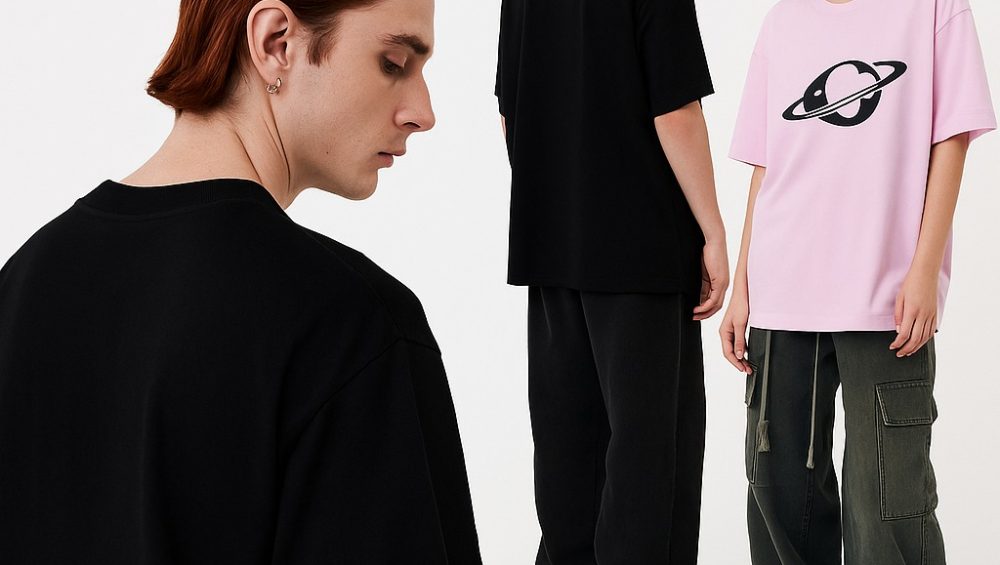Introduction
Few garments are as universally recognized, comfortable, and versatile as the humble T-shirt. With its simple, straight-cut shape, short sleeves, and crew neck, the T-shirt may appear basic at first glance. Yet behind this apparent simplicity lies a rich tapestry of history, culture, production methods, and design innovation. T-shirts have evolved from a practical undergarment to a primary form of self-expression, a canvas for artwork and protest, and a pivotal component of contemporary fashion. In this article, we will explore the origins of the T-shirt, its materials and manufacturing processes, the myriad styles and design variations that have emerged, its cultural impact around the globe, environmental concerns associated with its production and disposal, tips for care and maintenance, and predictions for its future in an ever-changing fashion landscape. Whether worn as a blank slate or a bold statement piece, the T-shirt embodies a unique intersection of comfort, creativity, and commerce—a garment that truly transcends boundaries.
Historical Origins
The term “T-shirt” first appeared in the early 20th century, derived from the T-shaped silhouette formed by its body and sleeves. However, its antecedents date back centuries. In the late 19th century, European navies began issuing lightweight, white cotton undergarments to sailors stationed in tropical climates. These garments were easy to launder, quick-drying, and provided superior comfort in hot, humid conditions—qualities that would define the T-shirt for decades to come.
During World War I, U.S. soldiers adopted similar cotton undergarments, and photographs from the trenches showcase servicemen wearing what look like rudimentary T-shirts beneath unbuttoned uniforms. Yet it was not until after World War II that the T-shirt began to gain popularity as outerwear. Returning GIs, accustomed to sleeping and working in their regulation “undershirts,” embraced them as informal daily wear. The 1951 film A Streetcar Named Desire featured Marlon Brando famously clad in a white T-shirt, projecting an image of rugged masculinity and cementing the garment’s place in popular culture.
By the 1960s and ’70s, textile manufacturers were experimenting with new fabrics, colors, and printing techniques, unleashing a wave of custom-printed T-shirts for advertising, political campaigns, and band merchandise. The T-shirt had shed its sterile, utilitarian origins and emerged as a vibrant, expressive medium enjoyed by people across all ages, genders, and social classes.
Materials and Manufacturing
At the core of every T-shirt lies its material composition. Traditionally made from 100% cotton, modern T-shirts now incorporate a variety of fibers to enhance durability, stretch, moisture-wicking, and cost-efficiency. Common materials include:
-
Combed Cotton: Cotton fibers that have been combed to remove shorter strands, resulting in a smoother, stronger yarn.
-
Ring-Spun Cotton: Yarn made by continuously twisting and thinning cotton strands, yielding a softer hand and finer texture.
-
Cotton-Polyester Blends: Combining natural cotton with synthetic polyester fibers to reduce shrinking, increase wrinkle resistance, and expedite drying times—often at the expense of some breathability.
-
Tri-Blends: A three-way blend (typically cotton, polyester, and rayon) that offers a soft, lightweight drape, and subtle sheen.
The manufacturing process begins with fiber sourcing—whether from cotton farms or polyester resin—and proceeds through spinning, knitting (usually a single jersey knit for T-shirts), dyeing or bleaching, cutting, sewing, and finishing. Advances in automation have streamlined many of these steps: computerized knitting machines can produce tubular fabric rolls, and precision cutting equipment reduces waste by nesting patterns optimally. Screen printing, direct-to-garment (DTG) printing, heat transfers, and embroidery are then used to apply designs or logos, each technique offering distinct advantages in cost, durability, and vibrancy.
Supply chains for T-shirt production are now global in scope. Raw cotton might be grown in the United States, India, or West Africa; yarn spun in China or Bangladesh; garments sewn in Vietnam or Central America; and final printing completed closer to the point of retail sale. This complexity allows brands to optimize for price, quality, and lead time—but also raises concerns about labor practices, environmental impact, and supply chain transparency.
Design, Cuts, and Silhouettes
One of the most compelling aspects of the T-shirt is its adaptability to countless cuts, fits, and silhouettes. Popular variations include:
-
Classic Crew Neck: The archetypal design, featuring a round neckline that sits at the base of the throat. Ideal for layering and casual wear.
-
V-Neck: A neckline that dips into a V-shape, elongating the neck and offering a slightly dressier appearance. Often favored by women’s and slim-fit lines.
-
Scoop Neck: A deeper, wider neckline—sometimes combined with cap sleeves—that creates a relaxed, modern vibe.
-
Henley: A T-shirt with a short button placket extending from the neckline, blending the comfort of a tee with the styling of a polo.
-
Ringer Tee: Defined by contrasting bands around the neckline and sleeve hems, popularized in the 1970s.
-
Boxy and Oversized Fits: Characterized by dropped shoulders and wider bodies, these styles cater to streetwear aesthetics and unisex appeal.
-
Slim and Fitted Cuts: Tailored to contour the torso, sleeves, and shoulders more tightly—favored in athletic and fashion-forward lines.
In addition to silhouette, details like shoulder seams (set-in vs. raglan), sleeve length (cap, short, three-quarter, long), and hem type (straight, curved, flags) further diversify the category. Designers leverage these variations to target specific demographics, climates, and activity levels, ensuring that the T-shirt remains relevant across seasons and cultural trends.
The T-Shirt as a Cultural Canvas
Beyond mere apparel, T-shirts serve as billboards for personal identity and communal belonging. The rise of screen printing in the 1960s enabled artists, musicians, and activists to disseminate slogans, logos, and imagery with unprecedented reach. Iconic examples include:
-
Band Merchandise: From The Rolling Stones’ tongue logo to Nirvana’s smiley-face, T-shirts have been central to music marketing and fan culture.
-
Political Messaging: The “I ♥ NY” design, Shepard Fairey’s “Hope” poster for Barack Obama in 2008, and countless protest tees reflect the T-shirt’s power to galvanize opinion.
-
Brand Collaborations: Premium fashion houses have embraced T-shirts as entry-level luxury items, collaborating with street artists, celebrities, and sports teams to command high price points.
-
Internet Memes and Viral Graphics: In the social media era, catchy phrases and meme images can drive T-shirt trends overnight, turning everyday wearers into walking advertisements for digital culture.
Moreover, T-shirts have played roles in social movements worldwide—from anti-war demonstrations to Pride parades—signaling solidarity and shared values. Their affordability and ubiquity make them ideal tools for grassroots communication: printing a short run of political T-shirts is cost-effective, easily distributed, and visually impactful.
Environmental and Ethical Considerations
The mass production of T-shirts has environmental consequences that demand attention. Conventional cotton farming relies heavily on water, pesticides, and land, leading to issues like soil degradation and water scarcity—famously exemplified by the shrinking Aral Sea, decimated partly by cotton irrigation. Polyester, derived from petroleum, contributes microplastic pollution when washed, introducing persistent fibers into waterways and ecosystems.
To mitigate these impacts, sustainable alternatives are emerging:
-
Organic Cotton: Grown without synthetic pesticides or fertilizers, reducing soil and water contamination.
-
Recycled Fibers: Post-consumer plastic bottles and textile waste can be reprocessed into polyester yarns, closing the loop on waste.
-
Innovative Materials: Bamboo viscose, Tencel (lyocell), and hemp offer renewable, biodegradable options with lower water footprints.
-
Waterless Dyeing and Digital Printing: New technologies that minimize water usage by up to 90%, compared to traditional dye baths.
-
Fair Trade and Ethical Manufacturing: Certifications like Fair Wear Foundation ensure workers receive living wages, safe working conditions, and reasonable hours.
Consumers can further reduce their environmental footprint by choosing durable, well-made T-shirts, washing them in cold water, air-drying instead of tumble drying, and recycling or upcycling worn-out tees. Brands are increasingly responding to demand for transparency: many now publish annual sustainability reports, list factory partners, and embed QR codes in labels linking to supply chain data.
Care, Maintenance, and Longevity
Extending the life of a T-shirt is both economical and ecological. Best practices include:
-
Washing Inside-Out: Protects printed designs and fabric fibers from abrasion.
-
Cold Water and Gentle Cycles: Reduces shrinkage, color fading, and energy consumption.
-
Air-Drying or Low-Heat Tumble Dry: Preserves fabric integrity and shape.
-
Minimal Use of Bleach or Harsh Detergents: Prevents fiber damage and yellowing.
-
Mending and Patching: Embracing visible repairs with embroidery or appliqués can add character and extend wear.
Proper storage—folded rather than hung—avoids shoulder stretching and unsightly hanger marks. With attentive care, a high-quality T-shirt can remain comfortable and stylish for years, delaying its entry into landfill or recycling streams.
The Future of the T-Shirt
As technology, fashion, and societal values evolve, the T-shirt will undoubtedly continue to adapt. Potential future developments include:
-
Smart Textiles: Integration of conductive fibers, sensors, and wearable electronics for biometric monitoring or interactive graphics.
-
On-Demand and Localized Manufacturing: 3D knitting and digital printing could enable micro-factories that produce customized T-shirts on-site, reducing shipping emissions and overproduction.
-
Biodegradable Polymers and Circular Economies: Materials engineered to return harmlessly to the environment or be fully recycled without quality loss.
-
Augmented Reality (AR) Apparel: T-shirts embedded with markers that trigger digital animations or information overlays via smartphone apps.
-
Enhanced Personalization: AI-driven design tools that allow consumers to generate unique graphics, colors, and fits tailored to their measurements and preferences.
These innovations promise to make T-shirts more sustainable, interactive, and aligned with individual identities—continuing the garment’s evolution from a simple undergarment to a dynamic cultural artifact.
Conclusion
The T-shirt’s journey—from a utilitarian piece of underwear to a global symbol of comfort, creativity, and cultural commentary—highlights its remarkable adaptability. Today, it stands at the crossroads of fashion, technology, and activism, serving as both a wardrobe essential and a powerful canvas for self-expression. As the industry grapples with environmental and ethical challenges, sustainable practices and innovative materials are reshaping how T-shirts are made, worn, and recycled. At the same time, digital technologies and shifting consumer values are redefining what it means to “wear” a T-shirt—whether as an interactive smart garment, a personalized fashion statement, or a testament to one’s beliefs. In every era, the T-shirt has proven its capacity to reflect the spirit of the times, and there is little doubt that this unassuming garment will continue to evolve, delight, and unite people around the world for generations to come.






